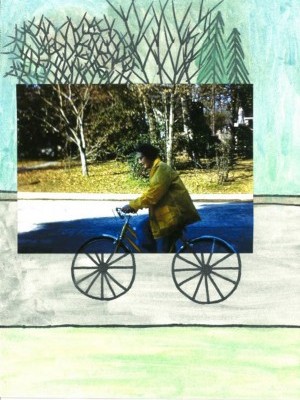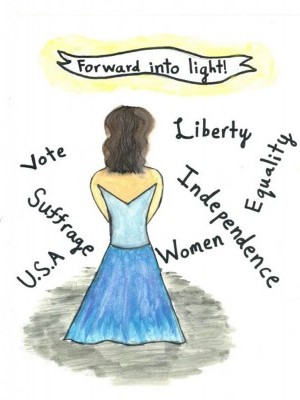Maya Peeders
Homeschool | DeForest, WI | 7th
Inspirational Family Member
My Great-Grandmother
My great-grandmother, Alice Adelaide Rosslip, was born on November 25, 1907. Alice's mother and father were immigrants from France, but Alice and her brother were born in America. She grew up in the town of Lyndhurst, New Jersey. Her father worked with an import/export business but had failing vision. Young Alice's job was to lead her father, who sat atop a horse, down to the station each day so that he could take the train to New York for his job. When Alice was 16 her mother's failing health brought an end to her life. Her brother Roland did not believe she should live alone with her father, who wasn't cut out for raising a child alone. He sent her to live with his mother-in-law. That was where Alice finished her childhood. Alice never completed high school; she instead spent her days working and saving money.
Alice married, becoming Alice Aldridge. However, rather than accepting the role that most married women took part in, she found ways to exert her independence. She voted in elections. She not only earned her driver's license, she also saved up enough money to buy herself a car. Both of these things were practically unheard of at the time. By the early 1950s Alice was the mother of four children, and she was determined to send them all to college. In order to accomplish this, she got herself a job. Once again, this was uncommon, as women were expected to stay home and run the house. Alice's hard work paid off. All four of her girls went to college. Even when she grew old, Alice continued to show signs of independence. When her children grew up, left the house, and married, she sent them checks and gifts, without the knowledge of her husband.
Alice was never involved in the fight to vote as she was only thirteen when the nineteenth amendment was passed. Her family supported the suffrage movement in general, but Alice's mother had health issues that prevented her from getting involved. Researching my great-grandmother helped me understand how women's rights were in that time period. While now women in the United States can go to college or get a drivers' license, when Alice was alive, those were things girls weren't expected to do. My mom has always talked to me about the importance of voting and even taken me with her to vote in all the major elections. Researching this project has made me glad I live in this time period where women have more rights than before.
Alice was a strong-minded, kind woman, who strove for independence. I loved learning about my great-grandmother, and while I never knew her, I wish I had. I am thankful that this project gave me the opportunity to learn more about the women in my family.
Historical Figure I Admire
Inez Milholland
Inez Milholland was born in New York in 1886. She was the eldest of three children, two girls and a boy. Her father ran a mail tube business that left the family very well off. Her privileged life was filled with culture, education, and plenty of physical activity. Inez's parents owned homes in both New York and London. It was in London that she attended Kensington, a girl's high school. However much she loved London, Inez planned to go to college in America. Eventually, she decided on Vassar College in New York City, but her diploma from Kensington was not accepted. Her parents, determined to send Inez to college, enrolled her in the Willard School for Girls. At Willard, Inez worked hard and earned an acceptable diploma. In the autumn of 1905, Inez tested into Vassar. There, she excelled in her studies and athletics. She was always working hard and trying new things. Not only did she win the college award for best all-around athlete, she starred in several school plays and joined multiple school clubs.
Inez spent the summer after her sophomore year in London, where she met a woman that helped to set her on her path as a suffragist. Emmeline Pankhurst was a suffragette who was working to gain women's voting rights in England through a pushier, more aggressive approach. Through Emmeline, Inez Milholland participated in some demonstrations with the Women's Social and Political Union and learned more about the women's voting rights effort in England. America seemed disappointing in comparison. Inez pointed this out when she returned to Vassar to begin her junior year, writing about the issue in the Vassar Miscellany. She was determined to bring the topic of women's suffrage to her college, but Vassar's president, James Monroe Taylor, was as against the movement as Inez was for it. He believed such discussion to be propaganda and forbid it on campus. Inez quickly found a loophole in this rule. She began hosting meetings in the college's adjacent cemetery, the first kicking off with fifty-six people. Because these meetings were not on the campus itself, they were allowed, and Inez continued to help organize them until her graduation in 1909. This group became known as the Vassar Votes for Women Club.
After graduating from Vassar, Inez dove deeper and deeper into the suffrage movement. Her first big moment as a suffrage orator was when she single-handedly halted a campaign parade for President William Howard Taft. She leaned out the window of a building being passed by the parade, speaking from a megaphone. Hundreds of men, both viewing and marching, stopped to watch the beautiful woman speak.
In 1909 Inez was accepted into the New York University School of Law. While in law school, she continued her work as a suffragist. After getting her degree in 1912, she helped to plan a massive Women's suffrage parade, to take place the day before President Woodrow Wilson was inaugurated. When the day came, Inez Milholland led the parade, wearing a white cape with matching gloves and a crown. She rode her horse, Grey Dawn. This is what she is best remembered for today.
In 1913, Inez met and married a Dutch coffee importer, Eugen Jan Boissevain. Although married women were expected to stay home, marriage didn't stop her suffrage work. She also joined the National Woman's Party to help bring about fair voting rights in America. On October 19, 1916, Inez collapsed while giving a speech. Ten weeks later she died in a hospital due to pernicious anemia.
The suffrage movement was met with strong opposition. Men didn't want women to be educated or to vote because voting equals power. In a time when women were expected to do nothing more than marry and stay at home, Inez went to college, earned a law degree, and inspired women to think for themselves. When she wanted a change, she stepped forward and worked to make that change happen. She was and is an example to others, and while she did not live to see women gain voting rights, I think she would be proud of how far the women of our country have come.
SOURCES +
What the Project Means to Me
When I started this project, I knew very little about the women's suffrage movement. I had the general idea, but I never knew exactly how hard women had to fight for a simple right such as voting. Researching Inez Milholland gave me a more in-depth view of what things used to be like for women. I was amazed at the effort it took to earn a right that everyone should have. I believe that voting matters because when each person contributes their opinions and ideas it can help to create a country which is ideal for everyone. I learned from Inez Milholland that sometimes we must fight to make things right, whether the issue is small or large.
I was also amazed at the strength of the women in my very own family. I never knew that my great-grandmother was as strong-minded as she turned out to be. Alice is someone I wish I could have known. I think I would have liked her. Not only was she clear to establish independence when it was rare for women, she was also hardworking and kind. She understood the importance of what women could do for the country by merely casting a vote. When she had the opportunity to make a difference, she took it, and became the first woman in my family to do so.
This project really showed me what a difference individuals can make, and how it can really show when people work together to make something happen, such as women's voting rights. I also learned how important independence is, and how lucky I am that I was born in a time when women don't have to fight for their rights. It makes me grateful for something that I once took for granted.
Explore the Archive
Deadline Extended
There's still time to join Women Leading the Way.
Become a part of our storytelling archive. Enroll your class today.
Join the Project


